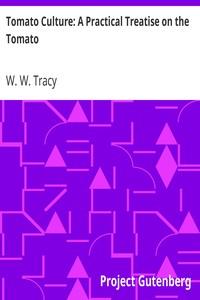Read this ebook for free! No credit card needed, absolutely nothing to pay.
Words: 30768 in 8 pages
This is an ebook sharing website. You can read the uploaded ebooks for free here. No credit cards needed, nothing to pay. If you want to own a digital copy of the ebook, or want to read offline with your favorite ebook-reader, then you can choose to buy and download the ebook.
when this is done it shows scarcely any fibrous structure--simply a mass of coarse cellular matter which while capable, when young, of transmitting nutritive matter rapidly, soon becomes dogged and inert. This structure not only makes the active life of the leaves short, like that of the roots, but necessitates a fresh growth in order to continue the fruitfulness of the plant and renders the leaves very susceptible to injury from bacterial and fungous diseases. The rapid growth also necessitates an abundance of sunlight.
Under glass it is generally necessary to assist the fertilization either directly by application or by motion of the plant, this latter only being effective in the middle of a bright sunny day. In the open ground in cold, damp weather the flowers often fail of fertilization, in which case they drop, and this is often the first indication of a failing of the crop on large, strong vines. I have known of many cases where the yield of fruit from large and seemingly very healthy vines was very light because continual rains prevented the pollenization of the flowers. Such failures, however, do not always come from a want of pollen but may result from an over or irregular supply of water either at the root or in the air, imperfectly balanced food supply, a sapping of the vitality of the plants when young, or from other causes. Insects rarely visit tomato flowers and are seldom the means of their fertilization.
The quality of the fruit is largely dependent upon varietal differences, to be spoken of later, but it is also influenced by conditions of growth--such as the proportion of the nutritive elements found in the soil, the proper supply of moisture, the degree and uniformity of temperature and, most of all, the amount of sunlight. Sudden changes of temperature and moisture often result in cracks and fissures in the skin and flesh, which not only injure the appearance but affect the flavor of the fruit.
Essentials for Development
The great difficulty in winter forcing tomatoes under glass in the North comes from the want of sunlight during the short days of the winter months. Were it not for the short winter days of the higher latitudes limiting the hours of sunshine, tomatoes could be grown under glass in the northern states to compete in price, when the better quality of vine-ripened fruits is considered, with those from the Gulf states. Growers are learning that tomatoes can be profitably grown under glass during the longer spring days, and consumers are beginning to appreciate the superior quality of fruit ripened on the vine over that picked green and ripened in transit. At no time is this need of abundance of light of greater importance than when the plants are young and, if they fail to receive it, no subsequent favorable conditions will enable them to recover fully from its ill effects. It is not so much the want of room for the roots as of light for the leaves that makes the plants which have been crowded in the seed-beds so weak and unprofitable.
I once divided 100 young tomato plants, about 2 inches high, into four lots of 25 each, numbering them 1, 2, 3 and 4. The plants of lots No. 1 and 2 were set equal distance apart in box A, and those of lots No. 3 and 4 in the same way in box B; both boxes being about 16 inches wide, 40 inches long and 4 inches deep. The two boxes were set together across the side bench of a greenhouse with the outer edge against a board wall some 2-1/2 feet high, so that the plants at the end of the box near the wall received much less light than those at the other end. They remained there about five weeks and then were taken out and the plants set in the open ground. During the five weeks box A, containing lots No. 1 and 2, was changed, end for end, every day so that those two lots of plants received nearly an equal amount of sunlight, but box B was not changed so that lot No. 3, at one end of the box, was constantly near the walk and in the full light, while lot No. 4, at the other end of the box, was constantly near the wall and in partial shade. The effect on the growth of the plants was very marked. The plants of lot No. 4 were nearly twice as high, but with much softer stems and leaves than those of lot No. 3. The plants received equal care when set side by side in the open ground and at the time the first fruit was gathered seemed of equal size and vigor, but the total yield of fruit of lots No. 1, 2 and 3 was very nearly the same and in each case at the rate of over 100 bushels an acre more than that from lot No. 4. This is but one of the scores of experiences which have led me to appreciate, in some degree, the necessity of plenty of sunlight for the best development of the tomato.
Selection of Soil for Maximum Crop
Large yields of tomatoes have been, and can be, obtained from soils of varying composition, from a gumbo prairie, a black marsh muck, or a stiff, tenacious clay, to one of light drifting sand, provided other conditions, such as drainage, tilth and fertility are favorable. The Connecticut experiment station and others have secured good results from plants grown under glass in a soil of sifted coal ashes and muck, or even from coal ashes alone, the requisite plant food being supplied in solution. But a maximum crop could never, and a full one very seldom, be produced on a soil, no matter what its composition, which could not be, or was not put into and kept in a good state of tilth, or on one which was poorly drained, sodden or sour, or which was so leachy that it was impossible to retain a fair supply of moisture and of plant food.
Of the 10 largest yields of which I have personal knowledge and which ran from 1,000 to 1,200 bushels of fruit an acre, four were grown on soils classed as clay loam, two on heavy clay--one of which was so heavy that clay for making brick was subsequently taken from the very spot which yielded the most and best fruit--one on what had been a black ash swamp, one on a sandy muck, two on a sandy loam and one on a light sand made very rich by heavy, annual manuring for several years. They were all perfectly watered and drained, in good heart, liberally fertilized with manures of proved right proportions for each field, and above all, the fields were put into and kept in perfect tilth by methods suited to each case; while the plants used were of good stock and so grown, set and cultivated that their growth was never stopped or hardly checked for even a day. These conditions as to soil and culture, together with seasons of exceptionally favorable weather, resulted in uniformly large crops on these widely different soils.
The composition of the soil, then, as to its proportions of sand or clay is of minor importance as regards a maximum yield or as to quality of the fruit, except as it affects our ability to put and keep the soil in good physical condition. The tomato crop, however, particularly when the plants are trimmed and trained to stakes, as is the usual practice in the South, as seen in Fig. 12, with crops grown for early shipment, necessitates in the trimming and training of the plants and the gathering of the fruit when it is in the right degree of maturity for shipment a great deal of trampling of the surface regardless of whether it is wet or dry. Consequently if the surface soil has any considerable proportion of clay there is danger of compacting and even puddling it by working when wet, to the great detriment of the crop. Again, a more or less sandy surface soil can be much more easily worked than one with a large proportion of clay. For these reasons our choice of a soil for the lowest cost a bushel and probably for a maximum yield should be a rich sandy or sandy loam surface soil overlying a well-drained clay sub-soil. I would prefer one which was originally covered with a heavy growth of beech and maple timber, though I should want it to be "old land" at the time. Tomatoes do not succeed as well on prairie soils, particularly if they are at all heavy, as they do on timbered lands, but one need not despair of a profitable crop of tomatoes on any soil which would give a fair crop of corn or of cotton.
Exposure and Location
In sections where there is danger of the plants being killed by early fall frosts before they have ripened their entire crop, exposure of the field is sometimes of importance in determining the marketable yield.
Free books android app tbrJar TBR JAR Read Free books online gutenberg
More posts by @FreeBooks


: Bruin: The Grand Bear Hunt by Reid Mayne Zwecker Johann Baptist Illustrator - Adventure and adventurers Fiction; Hunting Fiction; Voyages around the world Fiction; Brothers Fiction; Bears Fiction









